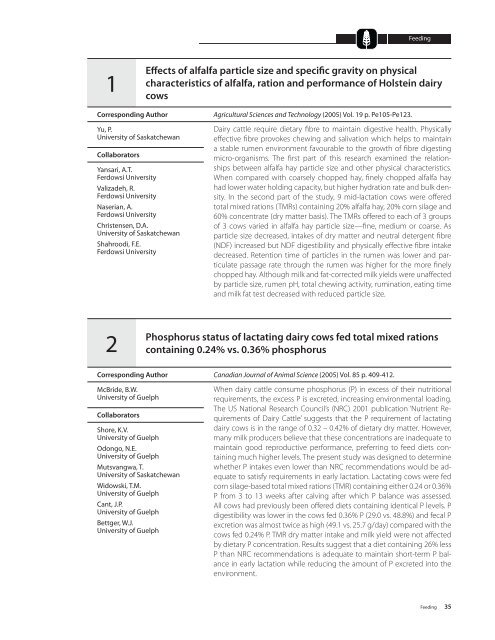A52-75-2007E.pdf - AgroMedia International Inc
A52-75-2007E.pdf - AgroMedia International Inc
A52-75-2007E.pdf - AgroMedia International Inc
Create successful ePaper yourself
Turn your PDF publications into a flip-book with our unique Google optimized e-Paper software.
Feeding1Effects of alfalfa particle size and specific gravity on physicalcharacteristics of alfalfa, ration and performance of Holstein dairycowsCorresponding AuthorYu, P.University of SaskatchewanCollaboratorsYansari, A.T.Ferdowsi UniversityValizadeh, R.Ferdowsi UniversityNaserian, A.Ferdowsi UniversityChristensen, D.A.University of SaskatchewanShahroodi, F.E.Ferdowsi UniversityAgricultural Sciences and Technology (2005) Vol. 19 p. Pe105-Pe123.Dairy cattle require dietary fibre to maintain digestive health. Physicallyeffective fibre provokes chewing and salivation which helps to maintaina stable rumen environment favourable to the growth of fibre digestingmicro-organisms. The first part of this research examined the relationshipsbetween alfalfa hay particle size and other physical characteristics.When compared with coarsely chopped hay, finely chopped alfalfa hayhad lower water holding capacity, but higher hydration rate and bulk density.In the second part of the study, 9 mid-lactation cows were offeredtotal mixed rations (TMRs) containing 20% alfalfa hay, 20% corn silage and60% concentrate (dry matter basis). The TMRs offered to each of 3 groupsof 3 cows varied in alfalfa hay particle size—fine, medium or coarse. Asparticle size decreased, intakes of dry matter and neutral detergent fibre(NDF) increased but NDF digestibility and physically effective fibre intakedecreased. Retention time of particles in the rumen was lower and particulatepassage rate through the rumen was higher for the more finelychopped hay. Although milk and fat-corrected milk yields were unaffectedby particle size, rumen pH, total chewing activity, rumination, eating timeand milk fat test decreased with reduced particle size.2Phosphorus status of lactating dairy cows fed total mixed rationscontaining 0.24% vs. 0.36% phosphorusCorresponding AuthorMcBride, B.W.University of GuelphCollaboratorsShore, K.V.University of GuelphOdongo, N.E.University of GuelphMutsvangwa, T.University of SaskatchewanWidowski, T.M.University of GuelphCant, J.P.University of GuelphBettger, W.J.University of GuelphCanadian Journal of Animal Science (2005) Vol. 85 p. 409-412.When dairy cattle consume phosphorus (P) in excess of their nutritionalrequirements, the excess P is excreted, increasing environmental loading.The US National Research Council’s (NRC) 2001 publication ‘Nutrient Requirementsof Dairy Cattle’ suggests that the P requirement of lactatingdairy cows is in the range of 0.32 – 0.42% of dietary dry matter. However,many milk producers believe that these concentrations are inadequate tomaintain good reproductive performance, preferring to feed diets containingmuch higher levels. The present study was designed to determinewhether P intakes even lower than NRC recommendations would be adequateto satisfy requirements in early lactation. Lactating cows were fedcorn silage-based total mixed rations (TMR) containing either 0.24 or 0.36%P from 3 to 13 weeks after calving after which P balance was assessed.All cows had previously been offered diets containing identical P levels. Pdigestibility was lower in the cows fed 0.36% P (29.0 vs. 48.8%) and fecal Pexcretion was almost twice as high (49.1 vs. 25.7 g/day) compared with thecows fed 0.24% P. TMR dry matter intake and milk yield were not affectedby dietary P concentration. Results suggest that a diet containing 26% lessP than NRC recommendations is adequate to maintain short-term P balancein early lactation while reducing the amount of P excreted into theenvironment.Feeding 35





